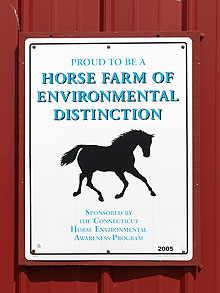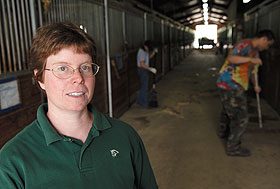  |
| HOME | THIS ISSUE | CALENDAR | GRANTS | BACK ISSUES | < BACK | NEXT > |
Environmental impact of horse manure can be lessened, says professorby Elizabeth Omara-Otunnu - June 23, 2008
| ||||
Jenifer Nadeau, a UConn animal science professor and extension specialist, is working to encourage Connecticut horse owners to adopt best management practices to help protect the environment. A single horse produces seven to nine tons of manure a year, says Nadeau, and Connecticut is home to approximately 50,000 horses, according to a survey she conducted in 2005 with Farhed Shah, an associate professor of agricultural and resource economics. Those numbers add up to a lot of manure, which contains nitrates and other organic matter. Runoff from the waste has the potential to have a significant impact on the state’s waterways. “When someone buys a horse and takes it home, they’re not thinking about seven to nine tons of manure and what to do with it,” says Nadeau. “But if they don’t have a plan for managing it, it can build up before they know it.” The Horse Environmental Awareness Program, or HEAP, aims to help Connecticut horse owners minimize the runoff that can pollute rivers and streams and will eventually end up in Long Island Sound.
Nadeau, an affiliated faculty member of the University’s Center for Environmental Sciences and Engineering, says pollution of water from horse manure has long been a problem, but it has been exacerbated by suburban sprawl in the state. “Previously many horse owners used to arrange with local farmers to take away their manure,” she says. “But as the suburbs have spread, the farms are becoming few and far between, making it less convenient and more expensive to truck the manure off site.” For several weeks a year, mostly in May, Nadeau and her colleagues visit farms in the state at the invitation of horse owners whom they have previously contacted. The group examines the entire process, from stall or paddock to disposal, using a scoring system to evaluate the various practices. Those who earn high marks receive a sign declaring the farm a Horse Farm of Environmental Distinction. Nadeau suggests that horse owners identify a level site for the manure pile, at least 100 feet away from any water well, but close to the barn or paddock for convenience. She recommends building walls of compacted soil or concrete to contain the manure, and a roof to keep rain out.
Composting the manure is ideal, she says, but requires equipment to turn it and keep it aerated. While composted manure takes four to six months to decompose, manure may otherwise take up to two years to fully break down. The danger of pollution is greatest when the manure is fresh, says Nadeau. Composting also helps reduce flies, parasites, and weed seeds because of the heat generated during decomposition. Nadeau also recommends that horse owners purchase fly predators – insects that prey on fly larvae – and add them to the manure pile. Additional strategies she advocates include rotational grazing, to minimize overgrazing which can contribute to erosion and runoff, and establishing a 35-foot buffer zone between areas where horses are kept and streams or ponds. “Grasses and shrubs help slow down pollution and absorb some of it,” she says. “They also help prevent erosion.” For horse owners, the benefits of effective management include healthier horses; better working conditions for humans; cleaner facilities; and fewer reasons for neighbors to object to horse facilities. For the environment, the benefits include reducing erosion and the sediment that erosion contributes to waterways; protecting the quality of surface and ground water from excess nutrients and disease-causing organisms; and reducing nuisances such as flies, mosquitoes, and dust. “It’s important that horse owners know help is available if they want to take the next step,” says Nadeau. “Anything people do that reduces pollution can have far-reaching effects.” The program also maintains a demonstration farm at Harkness State Park, and has produced a video about best management practices for horse owners.
This article includes material from a fact sheet produced by the Center for Environmental Sciences and Engineering. |
| ADVANCE HOME UCONN HOME |

 The program is run by a coalition of federal, state, and local agencies, as well as horse owners and businesses.
The program is run by a coalition of federal, state, and local agencies, as well as horse owners and businesses.